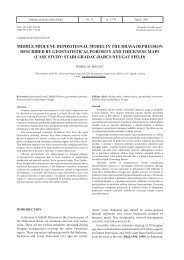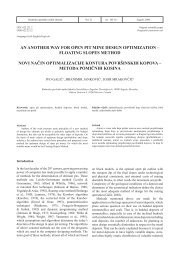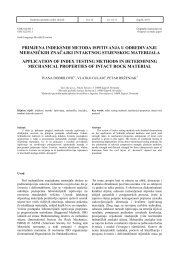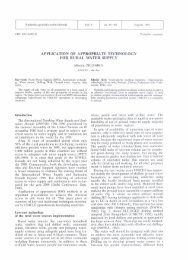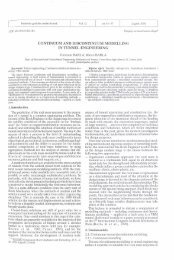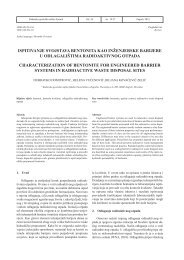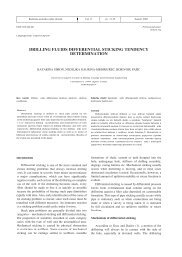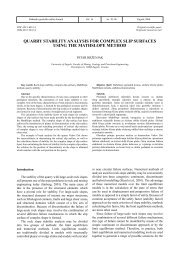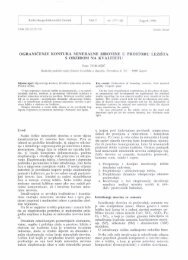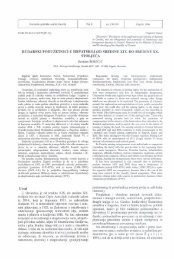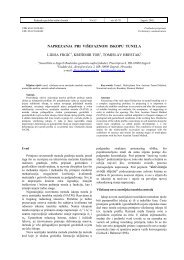TENSILE STRENGTH OF STEEL ROPES OF DIAMOND WIRE SAWS
TENSILE STRENGTH OF STEEL ROPES OF DIAMOND WIRE SAWS
TENSILE STRENGTH OF STEEL ROPES OF DIAMOND WIRE SAWS
- No tags were found...
Create successful ePaper yourself
Turn your PDF publications into a flip-book with our unique Google optimized e-Paper software.
Rud.-geol.-naft. zb., Vol. 13, Zagreb, 2001Dunda, S. & KujundiiE, T: Diamond wire saws86.6% cases and in 13.4% cases the rope broke along theedge of the joint, while the rope was pulled out from allthe sleeve couplings.The concise results of the testings of breaking load ofdiamond wire ropes and joints on them are presented in theTable 1. The names of specific rope manufacturers are notstated in the Table but they are replaced by the numbers1,2,3 and 4. 25 rope samples (total of 100) were testedfrom each manufacturer including the total of 100 jointswith L'male-female" threads and 50 sleeve couplings. Theaverage figures of breaking load of the rope and jointspresent the mean value of 23 tested samples, because thelowest and the highest values are not included in this averagevalue.Fig. 6. A more rare way of breaking of rope jointsSf. 6. Rjedi naEin prekida spojnih rnjesta uietaAnalysis of the resultsThe results of the testings (Tab. 1) show that the steelrope of diamond wire, which is used upon sawing of carbonatestone, can resist to approx. 3 times higher tensilestrength than the joints connected by "male-female" threadsand approx. 5 times higher strength than the joints connectedby sleeve couplings. Upon testing of complete ropebreaking the average breaking load was 17 898 N for theropes no. 1,13 779 N for the ropes no. 2,16 72 1 N for theropes no. 3 and 16 051 N for the ropes no. 4. The highestaverage value of breaking loads of joints with "male-female"threads was only 5 954 N (ropes no. 2) and 3 462 N(ropes no. 1) for the joints connected by sleeve couplings.These testings clearly show that the rope can resist to aconsiderably higher breaking load than the joints can. Accordingly,the critical points of breaking are joints too, notjust ropes. This means that it is not necessary to have ropesof high breaking load. More important is for them to be aselastic as possible. Therefore, the softer wire material canadditionally increase the rope elasticity.The diamond wire rope must have a small cross-sectionand mass but high tensile strength. Such a rope must beelastic and resistant to crushing, torsion, abrasion and corrosion.It is very difficult to select the rope constructionwhich meets all the requirements at the same time, sincesome of them exclude one another. The wires of larger diameterhave higher tensile strength but lower bendingstrength at the same time and V.V. By increase of wire hard-ness the tensile strength is increased, but the bendingstrength is decreased. The tougher material is, the rope isharder and more brittle (the interdependence is not proportionalbut appears in lower progression). Since the ropejoints have considerably smaller breaking resistance thanthe rope itself, it is useful to use the ropes of lower tensilestrength, which at the same time increases its bendingstrength.During the testings of joints the breaking on the jointwas in most cases caused by the pulling out of the ropefrom the joint. This brings us to the conclusion that thebreaking load of the joint can be increased by better fasteningof the joints, i.e. larger pressing upon their fastening.However this is denied by other samples, whereby disconnectionwas caused by breaking of ropes along the edgeofthe joint. Tensile strengths, which caused such breaking,were the same or lower than those, which caused pullingout of ropes from the joints. This means that fastened jointswith larger pressing cause squeezing and loosing of ropesat the joint, which again means that fastening ofjoints withlarger pressing will not enlarge resistance to breaking ofthe joint.The testing results show that the ropes, which are usedfor shaping of diamond wires, can resist to high breakingload (they have a high pulling strength) i.e such high resistanceto breaking is not necessary since the joints betweenseparate rope sections cannot resist to this breaking loadanyway. This conclusion is proved by additional testingsthat we conducted on used ropes. These ropes resisted toapproximately the same (in some cases even higher) breakingloads as the new ropes, although the control of the sarnplesshowed that in each sample there was a considerablenumber (8-17%) of broken wires.The changing tensile strength, bending, rubbing andcrushing finally cause breaking of some rope wires. Despitethe fact that the broken wire presents the correspondingdecrease of the metal cross-section (and safety) of therope on the breaking point, due to the rubbing it takes overits part of the force in the rope on the particular length.Therefore the broken wire has along its length the limitedimpact on the tensile resistance of the rope as a whole.ConclusionUpon operation diamond wire as a whole and diamondwire rope were stressed by tension, exposed to static anddynamic friction forces as well as to constant bending oversmall radius of curvature. The rope was also exposed tocorrosion and deterioration. The stresses by kinetic impactswere unpleasant. High velocities of diamond wires producealso vibrations of the rope, caused by dynamic forces, whichlead to fatigue and recrystallisation of steel. Material fatigueis increased due to the uninterrupted sawing process,because wire material cannot have complete elastic deformations.Laboratory testings of breaking loads of ropes of diamondwire saws and joints on ropes showed that the ropecan resist to a manifold higher breaking load than the jointscan. Former trial testings of the ropes (Dun d a, 1998)have showed that the increased deterioration of diamondwire is mostly caused by partially too heavy stressing, sincethe rope is not with its entire surface in contact with thedriving pulley, leading pulleys and cutting surface. Thebeads on the rope are in contact with the coating of thedriving pulley, so only some parts of the wire in the roperesist upon the inner ring of the bead. Therefore appearsthe partial stress and wire crushing which causes the deformationof the rope and its too early deterioration. This isthe reason why the rope should be softer and more rounded



